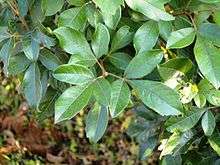Searsia pyroides
Searsia pyroides, previously known as Rhus pyroides, (common currant-rhus English, gewone taaibos Afrikaans, nhlokoshiyane isiZulu) is a species of Searsia, native to southern Africa. This tree occurs throughout the whole of South Africa, a part of Botswana, Zimbabwe and Tanzania and in some areas of Namibia near Windhoek.
| Searsia pyroides | |
|---|---|
 | |
| Scientific classification | |
| Kingdom: | Plantae |
| Clade: | Tracheophytes |
| Clade: | Angiosperms |
| Clade: | Eudicots |
| Clade: | Rosids |
| Order: | Sapindales |
| Family: | Anacardiaceae |
| Genus: | Searsia |
| Species: | S. pyroides |
| Binomial name | |
| Searsia pyroides (Burch.) Moffett | |
| Synonyms[1] | |
| |
It is very variable in all respects, though it is usually bushy and often thorny. It is found in bushveld, dry thornveld, on rocky hillsides, termite mounds, water courses and even on the fringes of forests. It is very hardy, tough, drought resistant and deciduous.
The leaves are attractive and trifoliolate and it sometimes has large, woody thorns.
Flowers are very small, greenish[2] and are borne in summer. The male and female flowers are borne on separate trees and the female trees bear small fruits 3–4 mm in diameter, which turn red when ripe.
The tree attracts a multitude of birds and insects due to its nutritious fruit and is an attractive addition to a garden. It is a host plant for the moth Xylopteryx arcuata.
References
- The Plant List: A Working List of All Plant Species, retrieved 26 April 2016
- "Searsia pyroides". PlantZAfrica.com. Retrieved 2010-02-04.
- Van Wyk, Braam; Van Wyk, Piet (1997). Field Guide to Trees of Southern Africa. Struik. ISBN 978-1-86825-922-9.
![]()